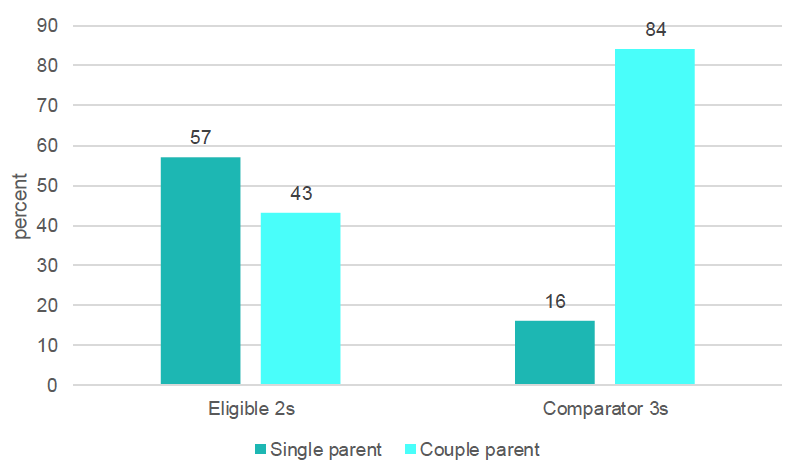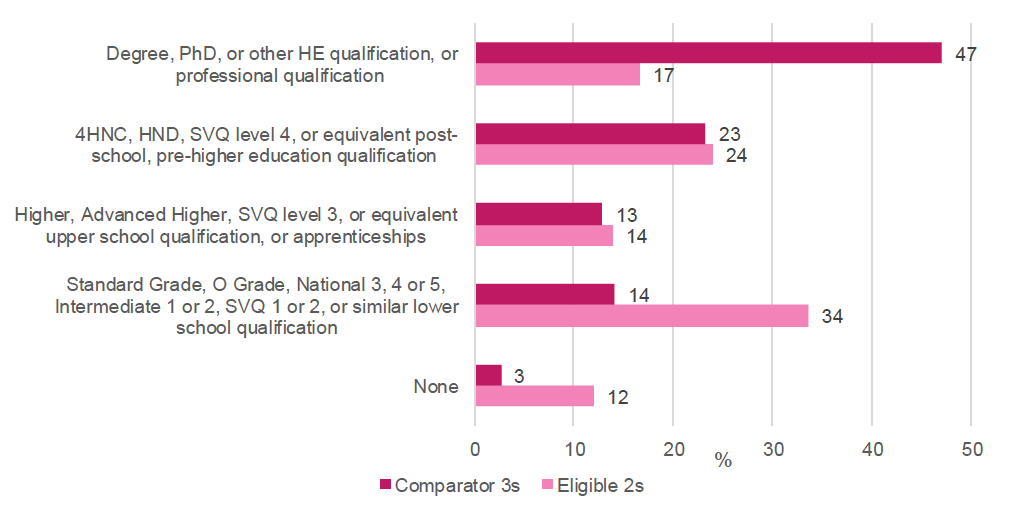Scottish Study of Early Learning and Childcare: Three-year-olds (Phase 3) Report - Updated 2021
Findings from the third phase of the Scottish Study of Early Learning and Childcare (SSELC), a research project established to evaluate the expansion of early learning and childcare in Scotland.
Child, parent and household characteristics
Characteristics of the cohorts
This report focuses on findings for two distinct cohorts of children and their families. The 'Comparator 3s', are a random sample of children aged between 3 years and 3 years 6 months, nationally representative of children of that age receiving 600 hours of funded ELC. The 'Eligible 2s' are a group of children, largely from lower income households, followed up one year after their participation in Phase 1 of the study. The figures used in this section are unweighted for both cohorts, so should be taken as only being representative of the sample rather than of the population as a whole.
For around 80% of the Eligible 2s group their 'eligibility' derives from the fact that they were eligible for 600 hours of statutory funded ELC at the age of two because they were the subject of a kinship care order or a guardianship order, or because their parents were in receipt of one or more qualifying benefits. The other 20% were receiving ELC through local councils using their discretion to offer funded or subsidised ELC over and above the legal entitlement, to provide support for a wider range of families. Discretionary funding from the local authority, commonly through referral from a social worker, health visitor or other professional, is often for children with additional needs, as well as for families that need extra support. Because of the small numbers, we do not distinguish between these two groups in most of the analysis, except where there is a very obvious difference, for example when looking at long-term health conditions.
There were noticeable differences in the compositions of the two samples. As can be seen in Figure 1, 57% of the households of the Eligible 2s were single parent families[14], whereas for the Comparator 3s this figure was 16%. Half of the Eligible 2s (49%) lived with only one person aged 16 or above[15] in the household, 41% lived with two and 10% lived with three or more. For the Comparator 3s, only 13% lived with one adult in the household, 79% lived with two and 7% lived with three or more. A third (30%) of the Eligible 2s were the only child in the household, compared with a quarter (25%) of the Comparator 3s; a further third (34%) of the households of the Eligible 2s had 3 or more children in them, compared with one fifth (20%) of the households of the Comparator 3s.

Base: All respondents (parent survey, unweighted)
Figure 1: Household composition Description. The level of education among parents/carers who responded to the parent questionnaire was higher for the Comparator 3s than for the Eligible 2s. A full breakdown of educational attainment is given in Figure 2. As can be seen, nearly half (47%) of the parents of the Comparator 3s had a university degree or equivalent, compared with one in six (17%) of the Eligible 2s. At the other end of the spectrum, 12% of parents of the Eligible 2s had no formal educational qualifications, and a further 34% lower school qualifications only (such as Standard Grade, or National 3, 4 or 5), compared with 3% of the parents of the Comparator 3s having no formal qualifications and 14% lower school only.

Base: All respondents (parent survey, unweighted)
Figure 2: Highest level of education of respondent. This clustered bar chart compares education levels of parents of Eligible 2s and Comparator 3s. It shows that 47% of the parents of the Comparator 3s had a university degree or equivalent, compared with 17% of the Eligible 2s. Similar proportions had post-school or upper school qualifications. 12% of parents of the Eligible 2s had no formal educational qualifications, and a further 34% lower school qualifications only, compared with 3% of the parents of the Comparator 3s having no formal qualifications and 14% lower school only.
The Eligible 2s were more likely to be living in deprived areas than the Comparator 3s. Half (47%) of the Eligible 2s resided in the most deprived 20% of areas according to the Scottish Index of Multiple Deprivation (SIMD). A further 27% resided in the second, 13% in the third, 9% in the 4th and only 4% in the least deprived areas. In contrast the distribution for the Comparator 3s was much more in line with the general population, with roughly one fifth in each quintile (between 18% and 21%).
The Eligible 2s were also more likely to be living in lower income households than the Comparator 3s, reflecting the eligibility criteria for access to statutory funded provision of ELC for two-year-olds. If we divide household income into equivalised income deciles[16], we see that 42% of respondents in the Eligible 2s group were in the bottom decile for income[17], compared with 13% in the Comparator 3s. Three quarters (76%) of the Eligible 2s were in the bottom three deciles for household income[18], compared with 29% for the Comparator 3s.
Respondents in the Eligible 2s group tended to be younger than those in the Comparator 3s. The median age of the respondents in the Eligible 2s group was 31, with 42% under the age of 30, including 13% under the age of 25. The median age for respondents in the Comparator 3s group was 34, with 18% under the age of 30, including 4% under the age of 25.
The Eligible 2s and Comparator 3s were much more similar when it came to the ethnic background of respondents. Almost the same proportion of respondents were non-white: 4% of the Eligible 2s and 5% of the Comparator 3s. The majority in both samples were white Scottish, 86% of the Eligible 2s were in this category and 83% of the Comparator 3s, with the remainder being of white origin from other parts of the UK or the rest of the world.
Most respondents in both samples spoke only English at home: 90% of the Eligible 2s and 89% of the Comparator 3s. Only 2% in each group spoke only other languages at home.
Contact
Email: socialresearch@gov.scot
There is a problem
Thanks for your feedback